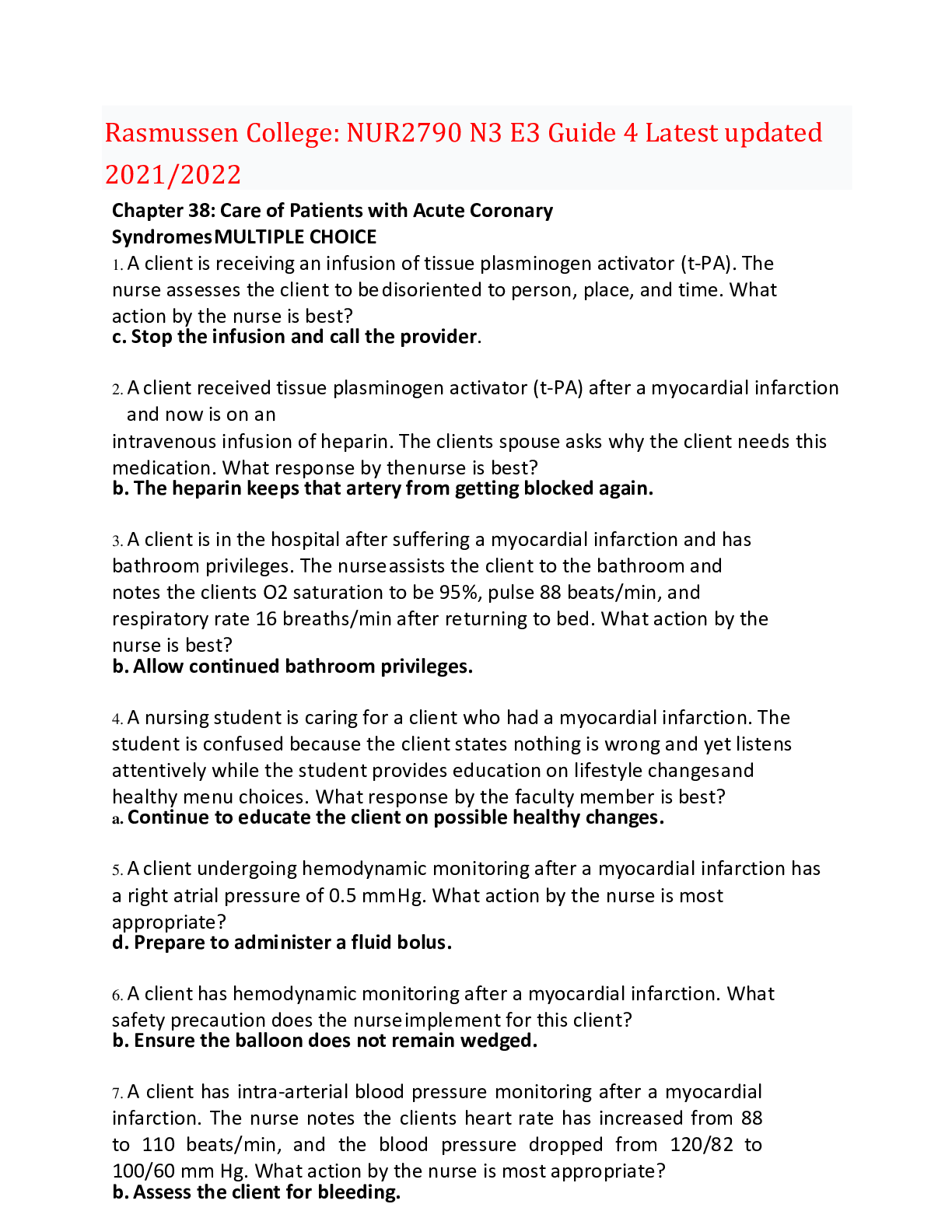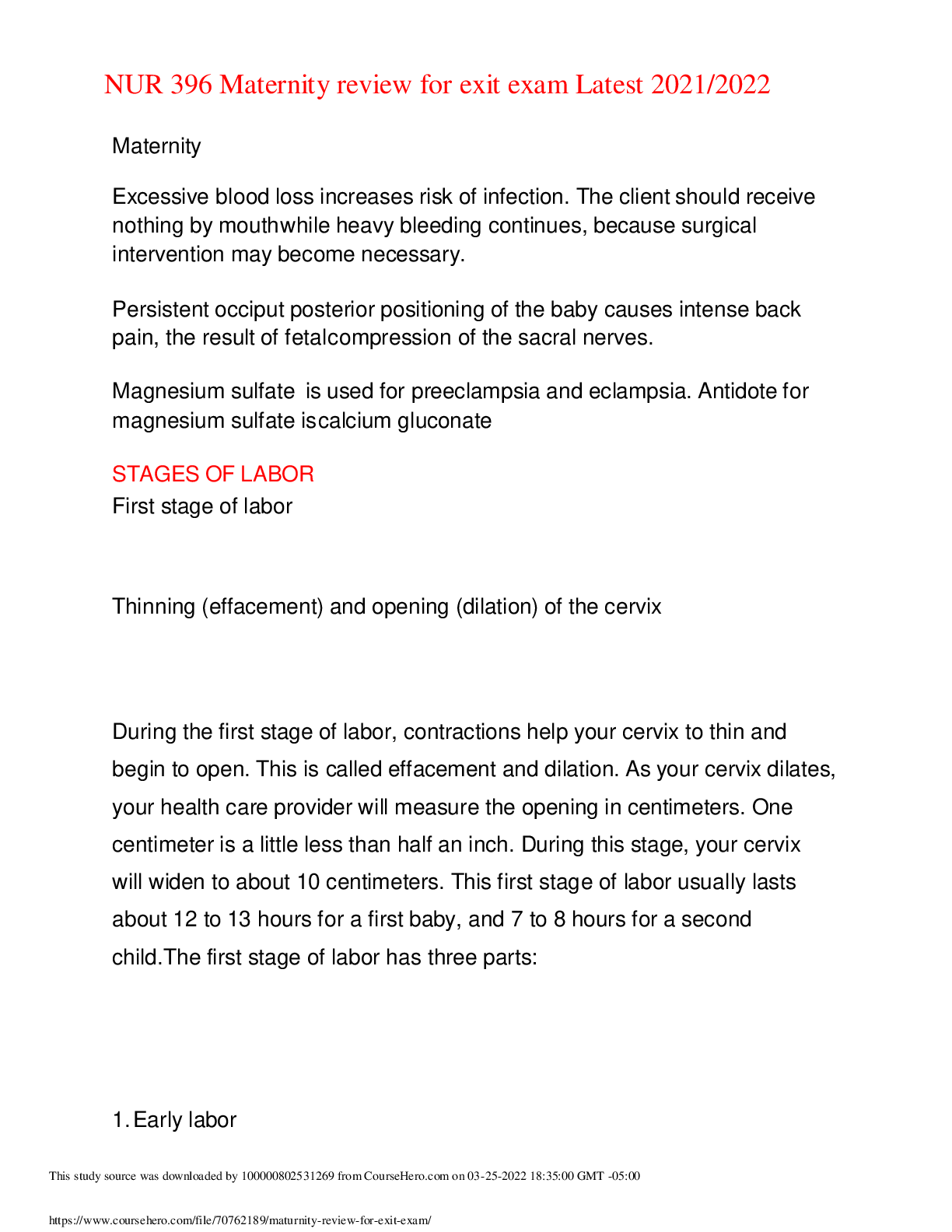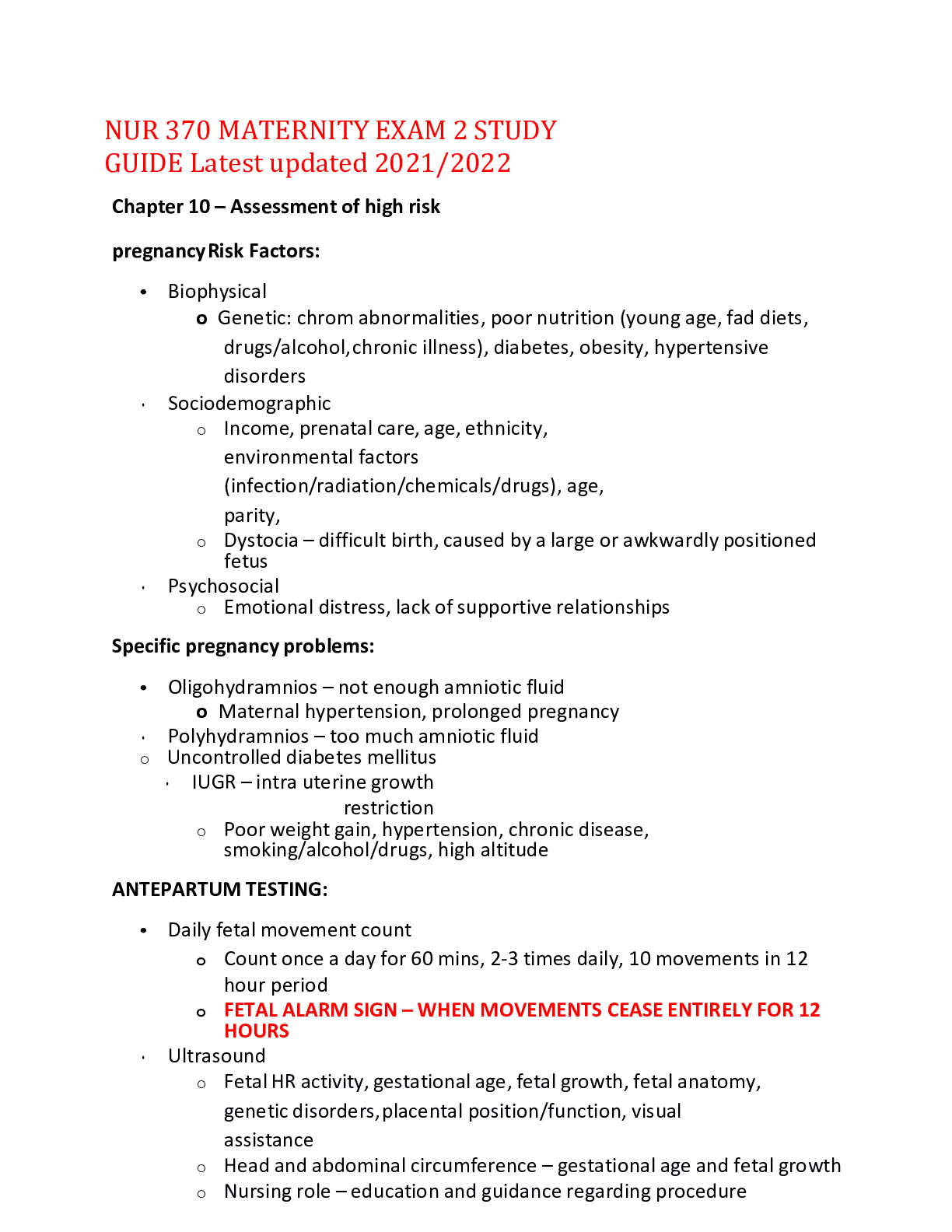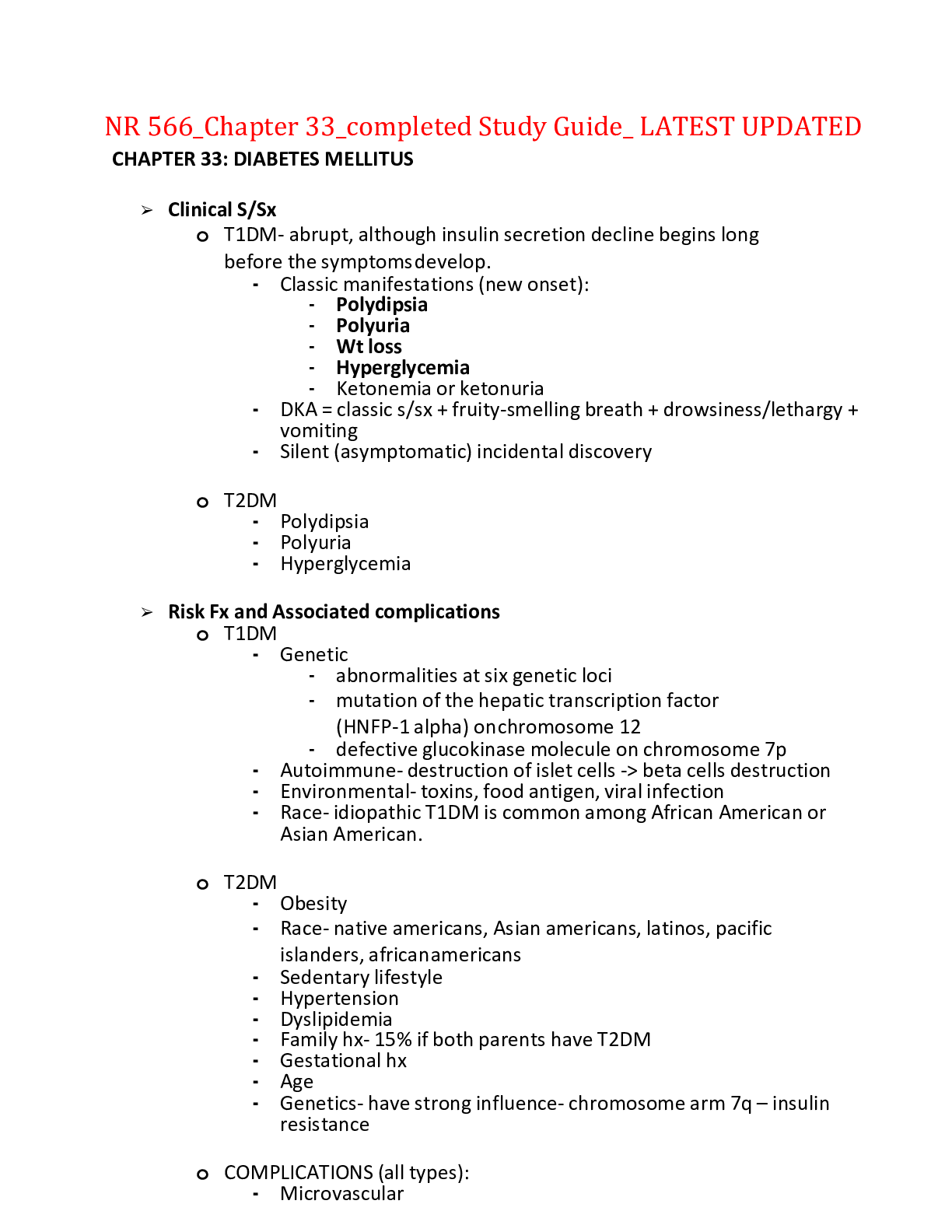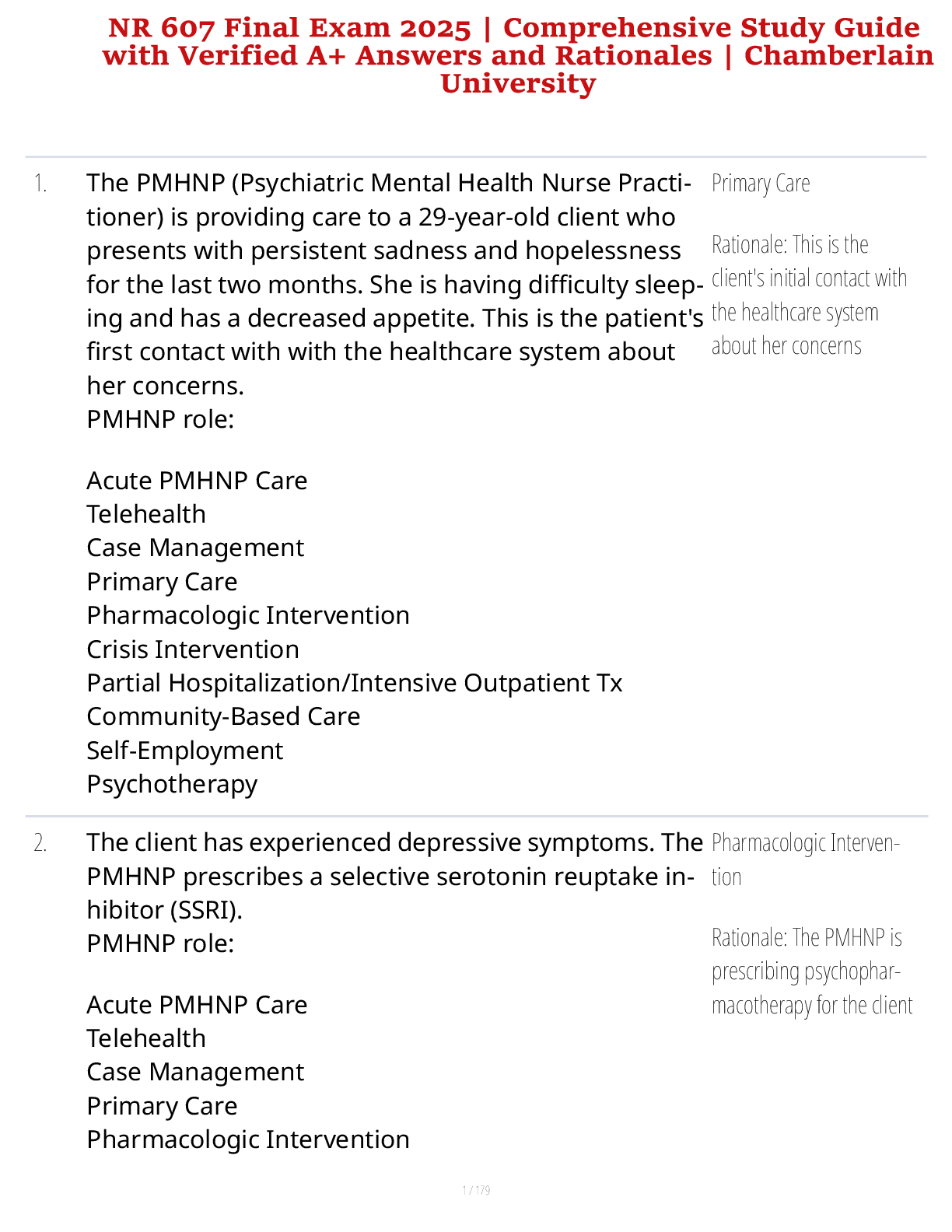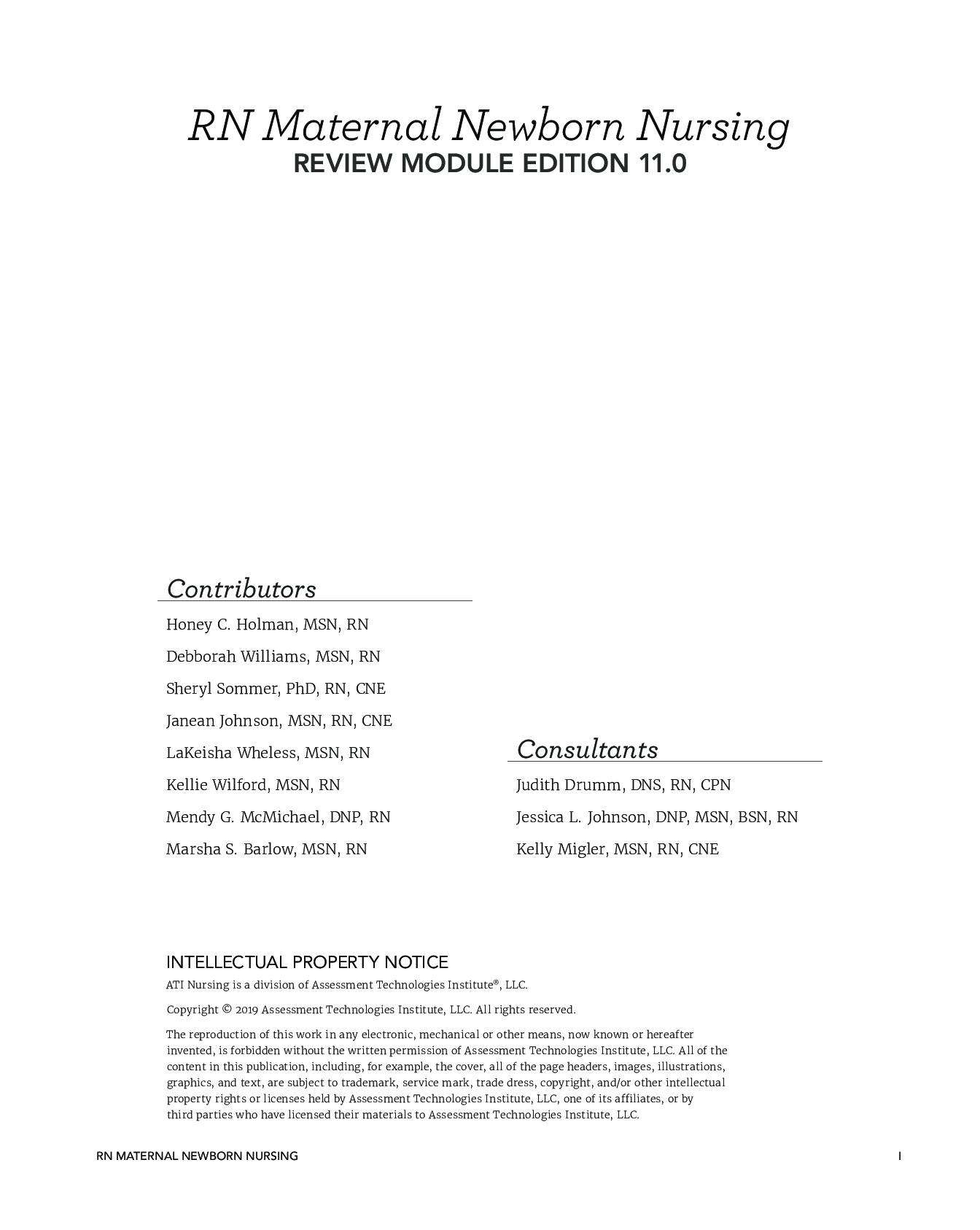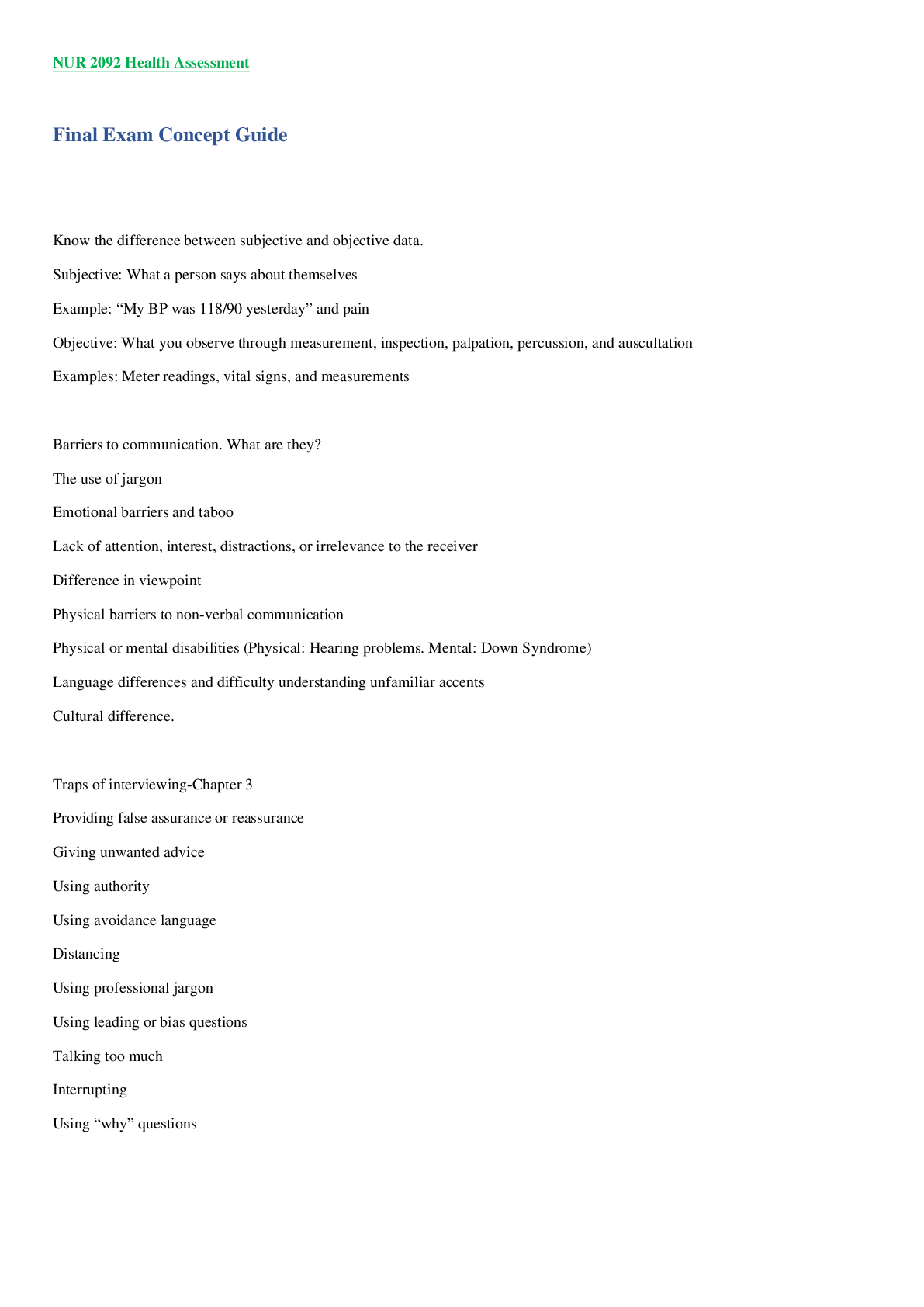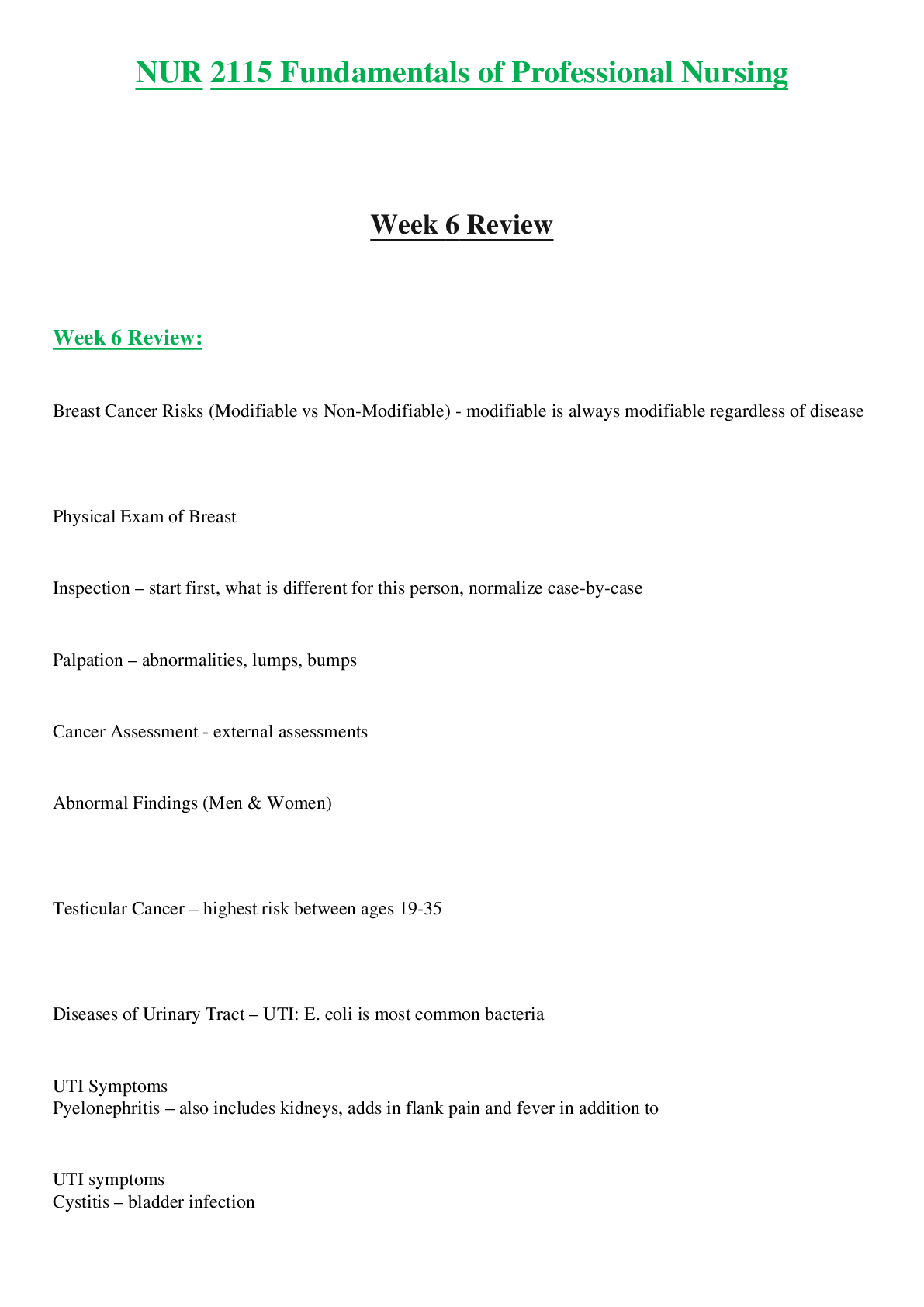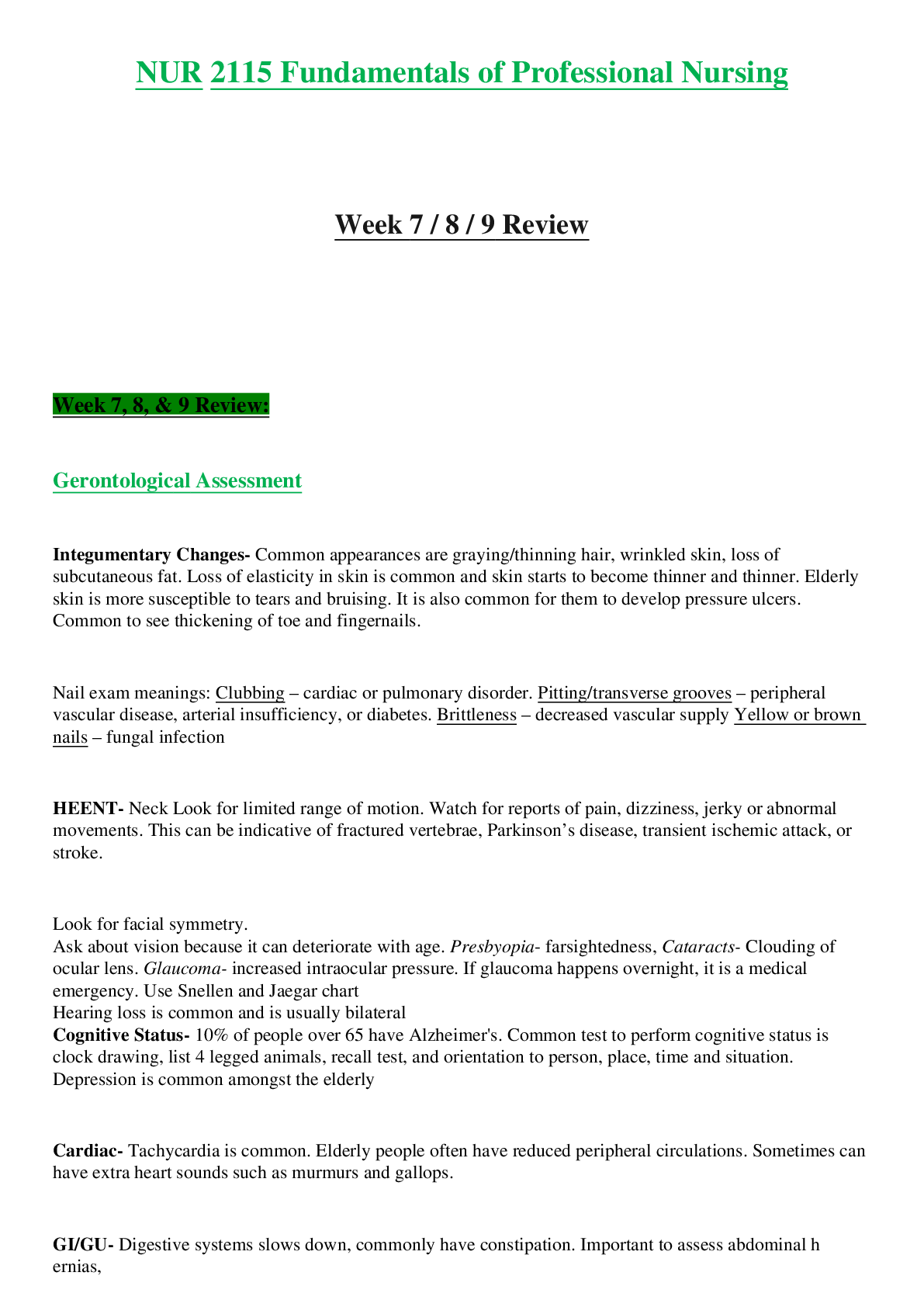NURSING 3SS3 Maternity Readings Part 1_Latest,100% CORRECT
Document Content and Description Below
NURSING 3SS3 Maternity Readings Part 1_Latest
Chapter 13
The process of labour and birth involves more than the birth of a newborn. Numerous physiologic and psych events occur
Initiation of
...
labour
Labour is complex and a multifaceted interaction between the mom and fetus
Series of processes in which the fetus is expelled from the uterus
Labour is influenced by a combo of factors including uterine stretch, progesterone withdrawal, increased oxytocin sensitivity and increased release of prostaglandins but the onset and maintenance of labour has not been proved scientifically
- One theory suggests that labour is started by a change in the estrogen to progesterone ratio
o During last trimester the estrogen levels increases and progesterone decreases which results in an increase in the number of myometrium gap junctions (connect cell membranes and facilitate coordination of uterine contractions and myometrial stretching)
- Number of oxytocin receptors in the uterus increases at the end of pregnancy which creates an increased sensitivity to oxytocin
o Estrogen increases myometrial sensitivity to oxytocin
o Increasing oxy levels in the maternal blood in conjunction with fetal production: uterine contraction can occur
o Oxy also aids in stimulating prostaglandin synthesis which can lead to additional contractions, cervical softening, gap junction induction and myometrial sensitization. This leads to progressive cervical dilation (open of external cerv os)
- Prostaglandins have a central role in the initiation of labor and they increase late during pregnancy secondary to elevated estrogen levels
o It stimulates smooth muscle contraction of the uterus
o Leads to myometrial contractions and a reduction in cervical resistance
o The cervix then softens, thins out, and dilates during labour
Premonitory signs of labour
Before labor a woman’s bod undergoes several changes in prep for the birth
- This often leads to signs and symptoms that suggest that labour is near
Cervical changes
- Cervical softening and possible cervical dilation with descent of presenting part into the pelvis (can occur 1 hour to 1 month before actual labour begins)
- Cervix changes from an elongated structure to a shortened thinned segment
- Collagen fibers undergo enzymatic rearrangement into smaller more flexible fibers that facilitate water absorption –softer more stretchable cervix
- Changes occur due to prostaglandins and pressure from Braxton Hicks
Lightening
- When fetal presenting part begins to descend into maternal pelvis
- Uterus lowers and moves into a more anterior position (breathing easier)
- Shape of abdomen changes as a result of the change in the uterus
- Can lead to increased pelvis pressure, cramping and lower back pain. Also vaginal discharge and more frequent urination as well as edema of lower extremities due to increased stasis of pooling blood
- First birth: occurs 2 weeks or more before labor starts
- Not first birth: may not occur until labour
Increased energy level
- Nesting – focus energy on childbirth by preparing, cleaning, cooking, nursing ready etc.
- Usually occurs 24-48 hours before onset of labor
Bloody show
- Onset of labor mucous plug that fills the cervical canal during preg is expelled due to cerv softening and increased pressure of presenting part
- Ruptured cerv caps release a small amount of blood that mixes with mucous resulting in pink tinged secretions known as bloody show
Braxton hicks contractions
- Tightening or pulling sensation at the top of the uterus
- Occur mostly in the abdomen and groin and gradually spread down before relaxing
- True labor – lower lack
- BH help move the cervix from a post position to an ant position and hep in ripening and softening the cervix
- Contractions are irregular and can be decreased by walking, voiding, eating, increasing fluids or changing position
- Usually last about 30 seconds but can last for as long as 2 minutes
- As birth draws near the freq and intensity of these increase.
- Pre-term labour: last longer than 30 sec and occur more than 4-6x an hour
- Late per-term: born between 34-36 weeks
Spontaneous rupture of membranes
- Precedes contraction in 10% of preg and in 40% of pre-term preg
- Sudden gush or a steady leak of amniotic fluid
- Most of fluid is lost when the rupture occurs, a continuous supply is produced to ensure protection of the fetus until birth
- After its ruptured the barrier to infection is gone and an ascending infection is possible
- Also danger of cord prolapse if engagement has not occurred with the sudden release of fluid and pressure with rupture
True versus false labor (chart on page 386)
- false occurs during the latter weeks of some preg in which irregular uterine contractions are felt but cervix isn’t affected
- True labour is characterized by contractions occurring at regular intervals that increase in freq, duration, and intensity. It brings about more progressive cervical dilation and effacement
- With first preg it can take 20 hours for cervix to dilate completely
Factors affecting the labour process
10 P’s
Passageway: birth canal
Route through which the fetus must travel to be born vaginally
Passageway consist of maternal pelvis and soft tissues
The maternal pelvis is relatively unyielding
Pelvis is assessed and measured during the first trimester to identify any abnormalities that may hinder a successful vaginal birth
Hormones relaxin and estrogen cause connective tissues to become more relaxed and elastic and cause joints to become more flexible to prepare mom’s pelvis for birth
Soft tissues usually yield to the forces of labour
Bony pelvis (page 387 picture)
- Divided into true and false portions
- False is composed of upper flare parts of the two iliac bones
- False and true divided by imaginary line called the linea terminalis
o False above, true below
- Ture pelvis is the bony passage through which the fetus must travel and has three planes: inlet, mid-pelvis and pelvis outlet
- Pelvis inlet: allows entrance to true pelvis
o Wider in transverse aspect side ways than it is from front to back
- Mid-pelvis: occupies space between the inlet and outlet that fetus must travel through
o As it passes through its chest is compressed, causing lung fluid and mucus to be expelled which removes the space-occupying fluid so that air can enter the lungs with the newborns first breath
- Pelvic outlet: wider from front to back
o For fetus to pass through, outlet must be large enough
o To ensure adequacy of the outlet for vaginal birth – pelvic measurement are done
o Diagonal conjugate of the inlet: distance between the anterior surface of the sacral prominence and the anterior surface of the symp pubis
o Transverse or ischial tuberosity diameter of the outlet: distance at the medial and lower aspect of the ischial tuberosities
o True or obstetric conjugate: 1.5 cm is subtracted from diagonal conjugate
o If diagonal conjugate is at least 11.5cm then pelvis is large enough for a vaginal birth for a normal sized newborn
- Pelvis shape: shape of pelvis is a determining factor for a vaginal birth (page 388)
o Four main shapes
o Gynaecoid
True female pelvis (50% of all women)
Vaginal birth most favorable with this because inlet is round and outlet is roomy
Optimal diameters in all three planes of pelvis
Allows early and complete fetal internal rotation during labour
o Anthropoid
Common in meds (25% of women)
Pelvis inlet is oval and sacrum is long, producing a deep pelvis (wider front to back)
Vaginal birth is more favorable than lat two types
o Android: male shaped pelvis (20% of women)
Funnel shape
Pelvis inlet is heart shaped and posterior segments are reduced in all pelvic planes
Descent of fetal head is slow and failure to rotate is common
Prognosis for labour is poor often leaded to C-section
o Platypelloid: flat pelvis and is the least common (5% of women)
Pelvic cavity is shallow but widens at pelvic outlet making it hard to fetus to descend through the mid-pelvis
Usually requires c-section
o Many women have a combo of all types
o Narrowest part of fetus attempts to align itself with the narrowest pelvis dimension – rotates to do this
Soft tissues
- Cervix, pelvic floor muscles and vagina
- Effacement the cervix things and dilates to allow presenting fetal part to descend into vagina
- Pelvic floor muscles help fetus to rotate anteriorly as it passes through birth canal
- Vagina – expands to accommodate fetus
Passenger: fetus and placenta
The following has an impact on the ultimate outcome in the birthing process
Fetal head
- Largest and least compressible fetal structure
- Considerable variation in size and diameter of the fetal skull
- Fetal head is large in proportion to the rest of the body
- Bones that make up the face and cranial base are fused and essentially fixed
- But bones that make up the rest of the cranium (two frontal bones, 2 parietal and occipital) aren’t fused but soft and pliable with gaps between the plates of bone
- Gaps are membranous spaces – called sutures and the intersection of these sutures are called fontanels
- They allow the cranial bones to overlap in order for head to adjust in shape when pressure is exerted on it by uterine contraction or maternal bony pelvis
o This process is known as moulding
- After birth sutures close as bones grow and brain reaches full growth
- Fluid or blood can collect in the scalp further distorting shape and appearance of fetal head
o Fluid: edema of scalp – swelling crosses suture lines – goes away 3-4 days
o Blood – doesn’t cross suture lines – reabsorbed over weeks to months
- Sutures help identify the position of the fetal head during a vag exam and the degree of rotation that has occurred
- See page 389 for a diagram of the sutures
- Ant and post fontanelles help determine position of fetal head and allow for moulding and important for eval newborn
o Anterior: soft spot and about 2-3cm. remains open up to 18 months after birth to allow for growth of brain
o Post: closes within 8-12 weeks and is 0.5-1cm
- Diameter of fetal skull are important (page 389 diagram)
o Subocciptobregmatic (smallest ant-post diameter of fetal skull) and bi-parietal (largest transverse diameter) affect birth the most
o Other two: occipitofrontal, occipitomental
- Cephalic headfirst
- (95% of all term births) if fetus is in flex position (chin resting on chest) the optimal or smallest fetal skull dimensions for a vag birth are there
o If head not fully flex – ant-post diameter increases and may prevent head from entering maternal pelvis
Fetal attitude
- Posturing (flexion or extension) of joints and the relationship of fetal parts to each other
- Most common is all joints flexed – fetal back rounded, chin on chest, thighs flexed on abdomen, legs flexed at the knees (most favorable for vag birth: smallest fetal skull diameters to pelvis presented)
- Abnormal attitudes (no flex or extension) increases diameters of presenting part
- Extension: larger fetal skull diameters making birth more difficult
Fetal lie
- Relationship of long axis (spine) of fetus to the moms
- Longitudinal most common: long axis are parallel
- Transverse: perpendicular – cannot be delivered vag
Fetal presentation
- Body part of fetus that enters pelvis inlet first
- Critical for planning and initiating appropriate interventions
- 3 main: breech pelvis first, cephalic head first, shoulder scapula first
- Presenting part usually occiput portion of fetal head (vertex presentation)
o Variations include military, brow and face presentations
- Breech: butt or feet enter maternal pelvis first and skull last – challenging
o Largest part of fetus is born last and can be hung up or stuck in pelvis
o Umbilical cord can become compressed between fetal skull and pelvis
o Butt is soft and not as effective as a cervical dilator
o Trauma to head due to lack of opportunity for moulding
o Types determined by positioning of fetal legs
o Frank 50-70%: butt first with legs extended to face (vag)
o Full/complete breech 5-10%: fetus cross-legged (c-section)
o Footing or incomplete breech 10-30%: one or both legs present (c-section)
o Associated with prematurity, placenta previa, previous breech, uterine abnormality, multiple fetuses, not first birth, congenital anomalies
- Shoulders first with head tucked inside
o Transverse lie
o Associated with placenta previa, multiple gestation or fetal anomalies
o C- section
Fetal position
- Relationship of presenting part of fetus to maternal pelvis
- Position indicated by 3 letter abbreviation
- First letter defines whether presenting part is tilted to the left (L) or right (R) side of maternal pelvis
- Second letter – presenting part of fetus. O for occiput (vertex), S for sacrum/bum (breech), M for mentum or chin (Face), A for acromion process (shoulder) and D for dorsal or back
- Third letter defines location of presenting part A for anterior portion of pelvis or P for posterior portion of pelvis and T or side of pelvis for transverse
- LOA is most common and most favorable (then ROA)
- Position allows fetal head to contour to diameters of moms pelvis
- LOP – long and difficult birth, other positions may not be good for vag birth
Fetal station
- Relation of presenting part to level of maternal pelvis ischial spines
- Measured in cm and minus or plus depending on loc above or below ischial spines
- Ischial spines typically narrowest part of pelvis and natural for measuring birth progress
- Zero station: presenting part level with ischial spines
- - station when presenting part is above ischial spines
- + when presenting part below ischial spines (+1 station – 1 cm below ischial spines)
- Farther away the presenting part from outside larger the neg number
- Closer the part to the outside the larger the positive number
Fetal engagement
- Entrance of largest diameter (bi-parietal) of fetal presenting part into smallest diameter of maternal pelvis
- Fetus engaged in pelvis when presenting part reaches 0 station
- Determined by pelvis exam
- First birth: 2 weeks before terms/ not first birth – several weeks b4 or not until labour
- Floating: engagement hasn’t occurred
Cardinal movement of labour
- the fetus goes through many positional changes as it travels through the passageway
o known as the cardinal movements of labor
- they are deliberate specific and very precise movements that allow the smallest diameter of the fetal head to pass through a corresponding diameter of the mother’s pelvic structure
- engagement: greatest transverse diameter of the head passes through pelvic inlet
- Descent: downward movement of fetal head until it is within the pelvic inlet.
o This occurs intermittently with contractions and is brought about by one or more of the following forces
Pressure of amniotic fluid
Direct pressure of fundus on fetus’ bum or head (depends on which part is located at top of the uterus)
Contractions of the ab muscles
Extension and straightening of fetal body
o Descent occurs throughout labour ending with birth – discomfort
- Flexion: vertex meets resistance from the cervix the walls of the pelvis or the pelvic floor
o Chin is brought into contact with the fetal thorax
o Achieves the smallest fetal skull diameter presenting to the maternal pelvic dimensions
- Internal rotation
o After engagement as the head descends the lower portion of the head meets resistance from one side of the pelvic floor
o Rotates about 45 degrees anteriorly to the midline
o Brings the ant-post diameter of the head in line with the ant-post diameter of the pelvic outlet
o Aligns long axis of fetal head with long axis of maternal pelvis
o Fetus must rotate to accommodate the pelvis
- Extension
o Resistance from pelvic floor causes the fetal head to extend so that it can pass under the pubic arch
o Occurs after internal rotation is complete
o Head emerges through extension under symphysis pubic along with shoulders
o Anterior fontanelle, brow, nose, mouth, and chin are born successively
- External rotation
o After head is born and free of resistance it untwisted causing the occiput to move about 45 degrees back to the original left or right position (restitution)
o Allows shoulders to rotate internally to fit the maternal pelvis
- Expulsion
o The rest of the body occurs more smoothly after the birth of the head and the anterior and posterior shoulders
Powers: contractions
- Primary stimulus powering labour is uterine contractions
o Complete dilation and effacement of the cervix during the first stage of labour
- Secondary powers: involve the use of intra-abdominal pressure (voluntary muscle contraction) exerted by the woman as she pushes and bears down during the second stage of labour
Uterine contractions
- Involuntary and therefore cannot be controlled by the woman whether they are spontaneous or induced
- Rhythmic and intermittent with a period of relaxation between contractions
- Pause allows the woman and the uterine muscles to rest.
- Pauses restores blood flow to the uterus and placenta which is temporarily reduced during each uterine contraction
- Uterine contractions are responsible for thinning and dilating cervix and they thrust the presenting part toward the lower uterine segment
- With each uterine contraction the upper segment of the uterus becomes shorter and thicker but the lower passive segment and the cervix becomes longer, thinner and more distended
- Division between contractile upper portion (fundus) of the uterus and the lower portion is described as the physiologic ring.
- Longitudinal traction on the cervix by the fundus as it contracts and retracts leads to cervical effacement and dilation.
- Cervical canal reduces in length from 2cm to paper thin and is described in terms of % from 0 to 100%
- First births typically start before the onset of labour and usually begins before dilation
- Not first birth: neither effacement or dilation may start until labour ensues
- Cervical canal 2 cm – 0% effaced
- Cervical canal 1 cm 50% effaced
- Cervical canal 0 cm – 100 % effaced
- Dilation is dependent on the pressure of the presenting part and the contraction and retraction of the uterus
- Diameter of the cervical os increases from less than 1cm to approx. 10cm to allow for birth
- When its fully dilated it is no longer palpable on vag exam
o Closed: 0cm dilated
o Half-open: 5cm dilated
o Fully open: 10 cm dilated
- During early labour uterine contractions are described as mild they last about 30 seconds, and they occur every 5-7 mins.
- As labour progresses contractions last longer (60 seconds), occur more frequently (2-3 minutes apart), moderate to high in intensity
- Each contraction has three phases: increment (buildup of contraction, acme (peak or highest intensity), and decrement (descent or relaxation of the uterine muscle fibers)
- Uterine contractions are monitored and assessed according to three parameters
o Frequency: how often contractions occur and is measured from the increment of one contraction to the increment of the next contraction
o Duration: how long a contraction lasts and is measured from the beginning of the increment to the end of the decrement for the same contraction
o Intensity: strength of contraction determined by manual palpation or measured by an internal intrauterine pressure catheter. Catheter is positioned in the uterine cavity through the cervix after the membranes have ruptured. Measures pressures of the amniotic fluid inside the uterus in mm of mercury
Intra-abdominal pressure
- Increased vol muscle contractions compresses the uterus and adds to the power of the expulsion forces of the uterine contractions
- Coordination of these forces in unison promotes birth of the fetus and expulsion of fetal membranes and placenta from the uterus
- Interference with these forces can compromise the effectiveness of these powers.
Psych response
- Physiologic aspects – influences self-confidence, self-esteem, and view of life, relationships and children
- Her state of mind (psyche) throughout the entire process is critical to bring about a positive outcome for her and her family
- Factors promoting a positive birth experience include clear info about procedures, support - not being alone, sense of mastery, self-confidence, trust in staff caring for her, and positive reaction to the pregnancy, personal control over breathing, prep for childbirth experience
- Anxiety and fear decrease women’s ability to cope with the discomfort of labor
- Maternal catecholamine’s secreted in response to anxiety and fear can inhibit uterine blood flow and placental perfusion
- Relaxation can augment the natural process of labor
- Preparing mentally for childbirth is imp so that woman can work with natural forces of labor
Position (maternal)
- Non-moving, back-lying positions during labor aren’t healthy
- Women continue to lie on their backs
o Belief that laboring women need to conserve ENG and not tire themselves
o Beliefs that nurses cannot keep track of whereabouts of ambulating women
o Belief that supine position facilitates vag exam and external belt adjustment
o Belief that a bed is where one is supposed to be in a hospital setting
o Belief that the position is more convenient for the delivering health professional
o Belief that laboring women are connected to thing things that impede movement
- Changing position and moving around during labor and birth offer several benefits
- Maternal position can influence pelvic size and contours
- Changing position and walking affects the pelvic joints which may facilitate fetal descent and rotation
- Squatting enlarges the pelvic outlet by approx. 25% whereas a kneeling position removes pressure on the maternal vena cava and helps to rotate the fetus in the post position.
- Upright or lateral position may reduce the length of the first stage of labor
o Reduce duration of the second stage of labor
o Reduce the number of assisted delivers (vacuum and forceps)
o Reduce episiotomies and perineal tears
o Contribute to fewer abnormal fetal heart rate patterns
o Increase comfort/reduce requests for pain meds
o Enhance a sense of control by the mother
o Alter shape and size of the pelvis which assists in descent
o Assist gravity to move the fetus down.
Philosophy: low tech, high touch
- Not everyone views childbirth in the same way but a continuum exists that extends from viewing labor as a disease process to a normal process
- One philosophy: women can’t manage the birth experience adequately and therefore need expert monitoring and management
- Women are capable reasoning individuals who can actively participate in their birth experience
- For many women in 21st century giving birth in a hospital has become intervention intensive designed to start, continue and end labor through medical management rather than allowing the normal process of birth to unfold
- Routine use of IV therapy, electronic fetal monitoring, augmentation, and epidural anesthesia are not supported by national or global practice guidelines.
- Family-centered birthing – low tech, high touch approach requested by many childbearing women who view childbirth as a normal process
- Registered midwives – fam centered birthing – fewer unnecessary interventions
o Women uses own instincts and bodily signs during labor
o Midwives empower women within the birthing environment
Partners: support caregivers
- Women desire attentive care during labor and birth from partners who can convey emotional support by offering their continued presence and words of encouragement
- Partner can be anyone who is present to support woman throughout the experience
- Women usually support other women in childbirth
- Continuous presence of a trained female support person (doula) reduced need for medication for pain relief, the use of vacuum or forceps delivery, and need for C section
o Slight reduction in the length of labor
o Doula experienced labor companion – provides woman and partner with emotional and phys support and info throughout the entire labor and birth experience
- More likely to give birth spontaneously – vaginally
o Slightly shorter labors – more likely to be satisfied
Patience: natural timing
- The birth process takes time. More time were allowed for women to labor naturally without intervention the c-section birth rate would most likely be reduced
- Current c-section rate 25.6/100 hospital deliveries (WHO recommends a rate of 10-15%)
- C-section birth is associated with increased morbidity and mortality for both mother and infant as well as increased in patient length of stay and health care costs
- Lots of unknowns when a woman starts labour: extent to which cervix soften and dilate, how long labor will last etc.
- Trend to manipulate the process of labour through medical means such as artificial rupture of membranes and augmentation of labor with oxytocin
- Amniotomy – artificial rupturing of fetal membranes may be performed to augment or induce labor when membranes have not ruptured spontaneously – allows fetal head to have more direct contact with the cervix in order to dilate it
o Performed with fetal head at -2 station or lower with cervix dilated at least 3cm
o Synthetic oxytocin is used to induce or augment labor by stimulating uterine contractions – piggybacked to IV lines
- Elective induction of labor sig increases risk of C-section birth
- Belief is that many c sections could be avoided if women were allowed to labor longer and if the natural process were allowed to complete the job. The longer wait usually results in less intervention.
- Induction should be offered at 41-42 weeks – decreased perinatal mortality without an increased rate of c-section
- Determination of gestational age should be based on ultrasound in first trimester
- Sweeping of membranes offered between 38 and 41 weeks
- Medical indications for inducing labor such as premature rupture of membranes and when labor doesn’t start – a preg more than 41 weeks gestation, maternal HTN, diabetes, or a uterine infection or fetal demise
- When laboring woman feels the urge to bear down, pushing begins
- Have patience and let nature take its course will reduce the incidence of physiologic stress in the mother, resulting in less trauma in her perineal tissue
Patient preparation: childbirth knowledge base
- Basic prenatal education can help women manage their labor process and feel in control of their breathing experience
- Woman is prepared – the labor is more likely to remain normal or natural
- Less likely to need analgesia or anesthesia and is unlikely to require a C section
- Teaches the women about childbirth experience and increases sense of control
- She is then able to work as an active participant during the labour and birth
- Prep can affect intrapartum and postpartum psych outcomes
- Sig effect on postpartum anxiety and adjustment
- Strengthen fams improving their life skills
Pain management: comfort measures
- Control pain without harm to the fetus or labor process is the major focus of pain management during childbirth
- Subjective – complex interaction of physiologic, spiritual, sensory, behave, cognitive, psycho, and cultural influences
- Culture influences perception and response to pain, as do anxiety and fear – tend to heighten pain sensitivity
- Find right combo of pain meds to keep the pain manageable while being mindful of the maternal and fetal outcomes
Physio response to labour
- Labor is physiologic process by which the uterus expels the fetus and placenta from the body
- During preg progesterone is secreted from the placenta suppresses spontaneous contractions of a typical uterus keeping fetus inside. Cervix remains firm and non-compliant.
- At term changes occur in cervix makes it softer. And uterine contractions become more frequent and regular, signalling the onset of labor
- The labor – rhythmic invol contraction that are quite Uncomfy
o Shortening of muscle fibers that causes effacement and dilation of cervix and a bursting of the fetal membranes
- Reflex and vol contractions of the ab muscles (pushing) the uterine contractions result in the birth of the baby
- During labor the mother and fetus make several physiologic adaptations.
Maternal response
- Stresses several of woman’s body systems – react through numerous compensatory mechanisms
- Heart rate increases by 10-20 bpm
- Cardiac output increases by 10-15% during the first stage of labour and by 30-50% during second stage
- BP increases by 10-30 mm mercury during uterine contractions in early stages
- WBC increases perhaps due to tissue trauma
- RR increases, and more oxygen is consumed related to increase in metabolism
- Gastric motility and food absorption decrease which may increase risk of nausea and vomiting during transition stage of labor
- Gastric emptying and gastric pH decrease increasing risk for vomiting with aspiration
- Temp rises a little possibly due to increase in muscle activity
- Muscle aches and cramps due to stressed MSK system
- Women’s ability to adapt to the stress of labor is influenced by psych and physical state – factors that may affect this
o Previous birth experiences and outcomes
o Current preg experience – planned or not, age, risk status, weight gain etc.
o Cultural considerations, support system
o Childbirth preparation – classes
o Exercise during preg
o Expectations of the birthing experience
o Anxiety level, fear of labor and loss of control, fatigue and weariness
Fetal responses
- If fetus is healthy stress of labor usually has no adverse effects
- Periodic fetal heart rate accelerations and slight decelerations related to fetal movement, fundal pressure, and uterine contractions
- Decrease in circ and perfusion to the fetus secondary to uterine contractions (healthy fetus can compensate for this drop)
- Increase in arterial carbon dioxide pressure
- Decrease in fetal breathing movements throughout labor
Stages of labour
- Four stages: dilation, expulsive, placental and restorative
- First stage is longest –starts with first true contraction and ends with full dilation (opening) of cervix
- Stage two begins when cervix is dilated and ends with birth of newborn – can last from minutes to hours
- Third stage starts after newborn is born and ends with separation and birth of placenta
o Continued uterine contractions typically cause placenta to be expelled within 5-30 minutes
- Fourth stage: lasts from 1-4 hours. Period when moms body begins to stabilize after hard work of labor and loss of conception products
Stage 1
- Progressive dilation of cervix. Gauged by vaginal exam and expressed in cm
- Stage ends when cervix is dilated 10cm and large enough to permit passage of a fetal head of average size
- Fetal membranes usually ruptures during the first stage – may have burst earlier or may remain intact until birth
- First birth –usually lasts 12 hours (not first birth usually only half that)
- Perceive visceral pain of diffuse abdominal cramping and uterine contractions
- Pain is usually a result of the dilation of the cervix and lower uterine segment and distension/stretching of these during contraction
- Three phases
- Latent: begins with start of regular contractions and ends when rapid cervical dilation begins. Cervical effacement occurs during this phase
o Contractions similar to period cramps
o Women can remain at home during this phase
- Active: cervical dilation begins to occur more rapidly during this phase
o Fetus descends further into the pelvis
o Becomes more absorbed in the serious work of her labor
o Use relaxation and paced breathing techniques
o Typical dilation rate for first birth is 1.2cm/hour
o Not first birth: 1.5 cm an hour
- Transition: dilation slows, most difficult but shortest phase for woman
- Average rate of fetal descent is 1cm/hour for first birth and 2cm/hour for not first birth
- Pressure on rectum is great and a strong desire to contract ab muscles and push
- Nausea and vomiting, trembling extremities, backache, increased apprehension and irritability, restless movement, increased bloody show, inability to relax, sweating, feelings of loss of control, being overwhelmed
Stage 2
- Previous stage of labor primarily involved the thinning and opening of the cervix
- Moving fetus through the birth canal and out of the body
- Cardinal movements of labor occur during early phase of passive descent in second stage of labor
- Mother feels more in control and less irritable and agitated and focused on pushing
- Longer the push, more damage to pelvic floor
- Release air during pushing to prevent build-up of intrathoracic pressure. it also supports mom’s involuntary bearing-down efforts
- Pushing can follow mom’s spontaneous urge or to be directed by the caregiver
o Support spontaneous pushing when woman is allowed to follow instincts
- Pushing is a modifiable risk factor in long-term perinatal outcomes
- Valsavla or holding breath bearing down and supine maternal position are linked to neg maternal fetal hemodynamics and outcomes
- Behaviors: push at onset of urge to bear down, use own pattern and technique of bearing down in response to sensation they experience, using open-glottis bearing down with contractions, pushing with variations in strength and duration, pushing down with progressive intensity, use multiple positions to increase progress and comfort
- Laboring down (promotion of passive descent) – for women with epidurals
- Two phases: pelvis and perineal related to existence and quality of the maternal urge to push and to obstetric conditions related to fetal descent
- Pelvic: fetal head in pelvis, rotating and advancing in descent
- Perineal: fetal head lower in the pelvis and is distending the perineum – strong urge to push – active pushing
o Perineum bulges and there is an increase in blood y show
o Fetal head becomes apparent at vag opening but disappears between contraction
o Crowned when fetal head no longer disappears between contractions
- Fetus rotates as it moves out
Stage 3
- Begins with birth of newborn and ends with separation and birth of the placenta
- Placental separation: after infant is born uterus continue to contract strongly and can now retract decreasing in size which causes placenta to pull away from uterine wall
o Signs that indicate placenta is ready to deliver: uterus rises upward, umbilical cord lengthens, sudden trickle of blood is released from the vag opening, uterus changes its shape to globular
o Spontaneous birth of placenta occurs in one of two ways: fetal side (shiny grey side) presenting first (Schultz’s mechanism) or maternal side (red raw side) called Duncan’s mechanism
- Placental expulsion: continued uterine contractions cause placenta to be expelled within 2-30 minutes unless there is gentle external traction to assist
o After placenta is expelled the uterus is massaged briefly until it is firm so that uterine blood vessels constrict minimizing possibility of hemorrhage
o Normal blood loss is about 500-600mL for a vag birth and 1000 mL for a c-section
o If placenta doesn’t spontaneously deliver the health care professional assists with removal by manual extraction.
o Inspect for intactness to make sure all parts are present
o Piece is still attached to uterine wall it places women at risk for postpartum hemorrhage because it becomes a space-occupying object that interferes with the ability of the uterus to contract fully and effectively
Stage 4
- Starts with completion of expulsion of placenta and membranes and ends with initial physio adjustment and stabilization of the mother
- Initiates the post-partum period
- Peace and excitement – wide awake and talkative
- Attachment process begins with her inspecting the newborn and desiring to cuddle and breastfeed him or her
- Moms fundus should be firm and well contracted – should be located at midline between umbilicus and symphysis and then rises to level of umbilicus during first hours
- Uterus boggy? Massaged to keep firm.
- Lochia is red and mixed with small clots and of moderate flow
- Episiotomy – should be intact with edges approx. and clean and no redness or edema
- Focus is to monitor mother closely to prevent hemorrhage, bladder distension and venous thrombosis.
- Mom often thirsty and hungry.
- Bladder hypotonic and limited sensation to acknowledge a full bladder or to void
- Vitals signs, amount and consistency of vag discharge (lochia) and uterine fundus are monitored every 15 min for at least an hour
- Cramp-like discomfort during this time due to contracting uterus
Chapter 18: Nursing management during the immediate newborn period
Parents faced with the task of learning and understanding as much as possible about caring for this baby – new or expanded role as parents and face many demands and challenges
Parents learn as they watch the nurse interacting with and care for their newborn
- Care should be individualized, and family centered
- Nurses play a huge role in teaching parents about a typical newborn characteristics and about ways to foster optimal growth and development
- Super important especially due to a decrease in hospital stays
Newborn comes from a dark small enclosed space in the mom’s uterus into the bright, cold extra-uterine environment
- Caring for a small human being who is experiencing their first taste of human interaction outside the uterus
- Newborn time is so important because they are so vulnerable
Intense how parents, family members and other visits observe the actions of nurses as they care or their new family member
- Nurses are a model for giving nurturing care to newborns and play a profound role in facilitating attachment between mom and newborns
- Mother and newborn should be viewed as a unit
Different assessments and interventions that are important in the newborn period
Parents is commonly used but great diversity in our population in terms of family structures and cultural practices related to birth and the many roles that moms, dads, aunts, uncles, other relatives, foster families, adoptive families and friends play in raising kids
Nursing management during the immediate newborn period
- Period of transition from intrauterine to extra uterine life occurs during the first several hours after birth and the newborn undergoes numerous adaptions
- Neonate’s temp, respiration, and CV dynamics stabilize
- Close observation of newborn is essential – to detect anomalies, birth injuries and disorders that can compromise adaptation to extra-uterine life
- Problems that occur at this time can have a lifelong impact
Assessment
- Initial assessment is completed in the birthing area – uncompromised baby placed directly on mom’s chest to remain warm and complete transition
- More thorough assessment done within first 2-4 hours once parents have had time to bond
- Ongoing vitals and physical assessments
- A third assessment is done before discharge
- Purpose is to determine whether the baby is transitioning effectively, to identify any abnormalities and provide parents with information and health teaching
- Initial newborn assessment look for signs that may indicate a problem: nasal flaring, chest retractions, grunting on exhalation, labored breathing, cyanosis, abnormal breath sounds like rhonchi crackle wheezing or stridor, tachypnea (>60 per minute), Bradypnea (<25 per minute), tachycardia (>160 bpm), bradycardia (<100 bpm), abnormal newborn size (small or large for gestational age)
- Medical intervention may be necessary if any of these findings are noted
Apgar scoring – page 525
- used to evaluate newborns at 1 minute and 5 minutes after birth
- an additional one is done at 10 minutes if 5 minute score is less than 7 points or if resuscitation is prolonged
- assessment of newborn at 1 minute provides data about the newborns initial adaptation to extra-uterine life
- 5 minutes: clearer indication of newborn’s overall CNS status
- Five parameters: A (appearance or color), P (pulse or heart rate), G (grimace or reflex irritability), A (activity or muscle tone), R (respiratory or respiratory effort)
- Each parameter is assigned a score ranging from 0 to 2 points
o 0 indicates an absent or poor response
o 2 indicates a normal response
- Newborns score should be between 8-10 points
- Rare to get a 10 because pink hands and feet are usually not seen in the newborn in the first few minutes of life
- Higher the score the better the condition of the newborn
- 8 r higher no intervention is needed other than supporting normal resp efforts and maintaining temp
- 4-7: moderate difficulty
- 0-3 represents severe distress
- Score influenced by a variety of factors, including the presence of maternal medications, infection and fetal malformations
- Physio depression the Apgar score characteristics disappear in a predictable manner: first the pink coloration is low, than resp effort, the tone, the reflex irritability and finally heart rate
Length and weight
- Accurate measurements are important because they provide a foundation for assessment of growth and development and are needed if infant requires fluids or meds during their stay in the hospital
- Taken within first 1-2 hours after birth
- Disposable tape measure or a built-in measurement board on side of scale is used
- Accurate length is challenging with a moving infant – board more accurate
- Length measured from head of newborn to the heel with newborn unclothed
- Place newborn in a supine position and extend leg completely
- Expected length is usually 48-53 cm (19-21 inches)
- Newborns are weighed using a digital scale that reads weight in grams
o Balance scale first, place warmed protective cloth or paper as a barrier on scale to prevent heat loss by conduction, recalibrate scale to 0, place unclothed newborn in centre of scale, keep hand above or safety
- Typical weight: 2500-400grams (5.5-8.5 pounds)
- Birth weights less than 10% or more than 90% on a growth chart are outside normal range and need more investigation
- Weights taken at later times are compared with previous weights and documented with regard to gain or loss on a nursing flow sheet
- Typically lose about 10% of their initial birth weight by 3-4 days of age secondary to loss of meconium and extracellular fluids and limited food intake
- Weight usually regained by 10th day of life
- Weight loss influenced by method of feeding – infants who are breastfed normally lose weight over a longer period of time and take longer to regain the weight loss
- Newborns can be classified by their birth weight regardless of gestational age
o Low birth weight – under 2500 grams (5.5 pounds)
o Very low birth weight – under 1500 grams or 3.5 pounds
o Extremely low – under 1000 grams or 2.5 pounds
Vital signs – see page 527
- HR and RR are assessed immediately after birth with APGAR
- Take apical pulse for 1 full minute – typically 120-160 bpm
- Can have resting heart rate as low as 80bpm depending on arousal level
- Newborns resp are assessed when they are quiet or sleeping – stetho on right side of chest and count breaths for 1 full minute to identify irregularities (normal RR – 40-60 breaths with symmetric chest movement)
- All babies at risk for temp instability because ability to regulate temp hasn’t fully developed (risk of hypothermia is real and can be dangerous)
o No contraindications – skin to skin thermal management encouraged which improves axillary temp 90 min after birth and improved ab temp as well
o Normal axillary temp is 36.6-37.5 – mild variations normal but wilder variations can be detrimental (thermometer/probe held in midaxillary space)
o Babies temp falls outside range – readings done every 15-30 min until temp is normalized
o Rectal temp not done due to risk of perforation
- BP not usually assessed unless there’s an indication or low APGAR score (oscillometer/electronic BP monitor is used)
o 50-75 SBP, 30-45 DBP
o Crying, moving and late clamping of umbilical cord increase SBP
o Right size cuff: bladder should entirely circle extremity without overlapping
Gestational (Stage of maturity) age assessment
- To determine this physical signs and neurologic characteristics are assessed
- Determined by Ballard Score System which provides an objective estimate of gestational age by scoring certain parameters of physical and neuromuscular maturity
- Points given: low score of -1 or -2 point for extreme immaturity to 4 or 5 points for post-maturity (scores added together to correspond to a gestational age in weeks)
o Higher score = more mature
- Physical maturity section done during first 2 hours of birth – phys characteristics that appear different at different stages depending on gestational maturity
o See chart on page 528
o Skin texture: range from sticky and transparent to smooth with varying degrees of peeling and creaking to parchment like or leathery
o Lanugo: soft downy hair on babies body. Absent in preterm, appears with maturity and disappears with post maturity
o Plantar creases: on soles of feet: greater creases = more mature. Range from absent to covering the whole foot
o Breast tissue: thickness & size of the tissue and areola (dark ring around nipple). Range from imperceptible to full and budding
o Eyes and ears: eyelids can be fused, or open and ear cartilage and stiffness determine degree of maturity (more cartilage with stiffness – greater maturity)
o Genitals: in males evidence of testicular descent and appearance of scrotum (range from smooth to covered with rugae) determine maturity
Females: appearance and size of clit and labia determine maturity
Prominent clit with flat labia suggest prematurity
Clit covered by labia suggest greater maturity
- The neuromusc maturity section is completed within 24 hours
o 6 activities are done with various body parts to determine maturity
o Posture: how does baby hold their extremities in relation to their trunk
Greater the degree of flexion the greater the maturity
Full flexion score of 4 points, extension is 0 points
o Square window: how far can babies hands be flexed to wrist
Angle measured (0-90 degrees)– angle decreases – maturity increases
o Arm recoil: how far do babies arms spring back to flexed position
Reaction of arm scored based on degree of flexion as arms are returned to their normal flexed position
o Popliteal angle: how far babies knees extend and measure angle
Less than 90 indicates greater maturity
o Scarf sign: how far can elbows be moved across chest
Elbows that don’t reach midline indicate greater maturity
o Heel to ear: how close can feet be moved to ears – assesses hip flexion
Lesser flexibility the greater the maturity
- 12 scores are totalled and then compared with standard values to determine gestational age (low score in preterm but high for mature and post-mature babies)
- Preterm/premature – born before 37 weeks regardless of birth weight
- Term – between 38 and 42 weeks
- Post-term or postdates – born after 42 weeks
- Post-mature born after 42 weeks and showing signs of placental aging
- Small gestational age – weight less than 10th percentile on standard growth charts (<5.5)
- Appropriate gestational age: weight between 10th and 90th percentile
- Large for gestational age: weight more than 90th percentile (usually >9 pounds)
Nursing interventions
Maintain airway patency
- Baby delivered and on mom’s chest – assess need for resuscitation by noting resp effort, heart rate and skin color
- Excessive secretions re noted that baby cannot clear on their own, consider oral or nasal suctioning and turn head to the side (secretions collect in check – removed easier)
- Suction mouth gently with a bulb syringe to remove debris and then nose is suctioned
o Prevents aspiration of fluid into lungs by an unexpected gasp
o Compress bulb before placing it into oral or nasal cavity, release it slowly making sure tip is away from mucous membranes to draw up excess secretions, remove syringe and then hold over a emesis basin and compress bulb to expel secretions
o Repeat until all secretions are removed
Skin-to-skin contact
- Begins right after birth and involves placing newborn covered in a warm blanket on moms bare chest
- Reduces maternal bleeding, improve oxygenation, stabilizes babies glucose, reduces crying, improves mom-baby interaction, maintain thermoregulation and assist with successful breastfeeding
- Newborn healthy and stable – wipe head to toe with dry cloth and place skin to skin on moms stomach – cover them with another warmed blanket to hold in warmth
- Takes advantage of newborn’s natural alertness after a vag birth and fosters bonding
- Can be done with father or another caregiver as well.
Initiating breastfeeding
- Right after birth since infants are most alert within the first 60-90 minutes
- Within half-an hour of birth is in WHO’s 10 steps to successful breastfeeding
- Leave baby alone on mom’s abdomen – healthy newborn moves up pushing with feet pulling with arms and bobbing head until finding and latching on to nipple
- Babies sense of smell is highly developed which helps in finding the nipple
- Mom produces lots of oxytocin as this happen – contracts uterus and minimize bleeding
o Causes breast to release colostrum which is rich in antibodies – babies first immunization against infection
Ensuring proper identification
- Attention to safety and security of a newborn is important
- Baby gets two id bracelets: one on wrist and one on ankle
- Mom receives a matching one usually on the wrist
- ID bands usually state the babies name, sex, date, and time of birth and ID #
- Same ID number is on bracelets of all family members
- Twins – each baby has own set of bracelets that will identify birth order (A for first)
- ID bracelets provide for safety of newborn and must be secured on mom and baby before they leave the birthing area
- ID bracelets checked by all nurses to validate that the correct newborn is brought to the right mother if they are separated at all
- Official newborn ID and are checked before initiating any procedure on newborn and on discharge
- Taking picture within 2 hours of birth with helps prevent mix-ups and abduction
Administering prescribed medications
- During immediate newborn period two meds are commonly ordered
- Vitamin k: Fat soluble vitamin promotes blood clotting by increasing the synthesis of prothrombin by the liver
o Deficiency would delay clotting and may lead to unexpected bleeding
o Generally bacteria of intestine produces vitamin K in adequate quantities
o Newborn’s bowel is sterile so vitamin k isn’t produced in the intestine until after microorganisms are introduced with the first feeding
o Admin of vitamin k is to prevent early vitamin K deficiency bleeding has been the standard of care for a long time
o Can be given as a single IM dose of 0.5 mg (<1500 grams), 1 mg for greater than 1500 grams to all newborns in the first 6 hours after birth following initial stabilization and an appropriate opportunity for maternal and family interaction
o Parents aren’t comfy with IM, oral vitamin K is available – three doses – increased risk for late hemorrhagic disease though
- Eye prophylaxis with either erythromycin or tetracycline ophthalmic ointment
o All babies: instillation or preventative agent in eyes ASAP
o Prevent ophthalmia neonatroum – chlamydia most common organism and gonococcal ophthalmia which can cause neonatal blindness
o Disease is a hyper-acute purulent conjunctivitis occurring during first 10 days of life – usually contracted during birth when baby comes in contact with infected vag discharge of mom
o Most often both eyelids become swollen and red with purulent discharge
o Should be instilled within 1 hour after birth
o Inform parents about eye treatment, why its recommended, what problems may occur if treatment isn’t given and possible adverse effects
Maintaining thermoregulation
- Trouble regulating temp especially during first few hours after birth
- Remember potential for heat loss in newborns and perform nursing interventions in ways that minimize heat loss and prevents hypothermia
- Dry infant, place a cap on their head, ensuring skin to skin contact with mom while infant is covered with a warm blanket all minimize heat loss
- Make sure newborn isn’t exposed to cold surfaces or cool drafts and warp newborn in warm blankets when skin to skin contact isn’t available
- Heat warmer needed: unwrap infant and put a sensor in place to monitor temp and avoid hyperthermia
- Measure temp with electronic thermometers in the axilla
- Temp should be between 36.3 and 37 and skin temp between 36.5 and 37
- Nursing interventions to maintain body temp include: promote skin to skin contact with newborn mother or other caregiver, dry newborn after birth to prevent heat loss through evaporation, cover or wrap baby in warn blanket t reduce heat loss via convection, warmed cover on scale to weigh baby to prevent heat loss through conduction, warm stetho and hands before exam baby or giving care, don’t place baby in drafts or near air vents to prevent heat loss through convection, put a cap on babies head after it is dried, avoid placing cibs near could outer walls to prevent heat loss through radiation, delay bath until babies temp has stabilized to prevent heat loss through evaporation and place baby in incubator or under a temp controlled radiant warmer if temp isn’t improving with other interventions
[Show More]
Last updated: 3 years ago
Preview 1 out of 22 pages



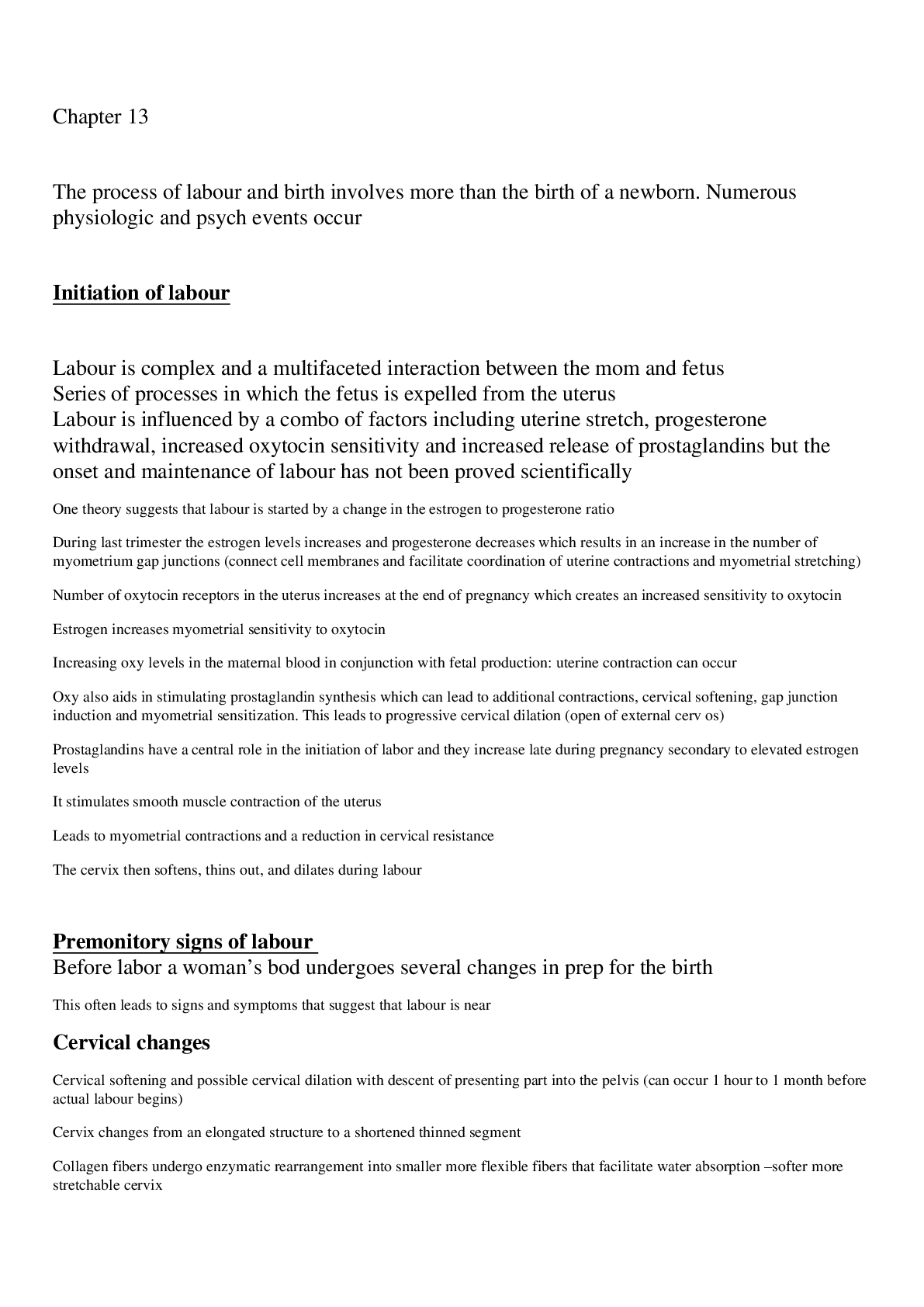
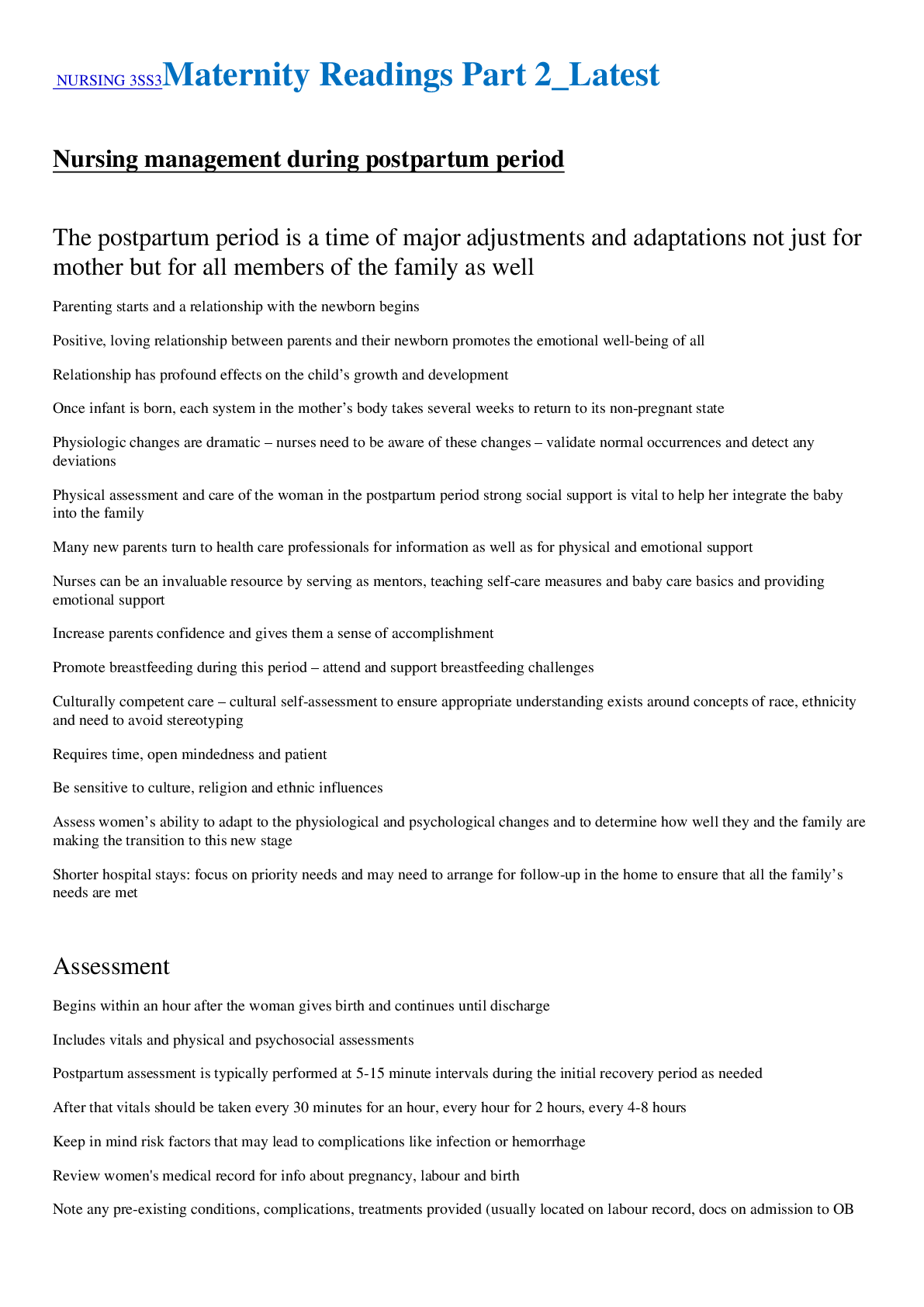

.png)



